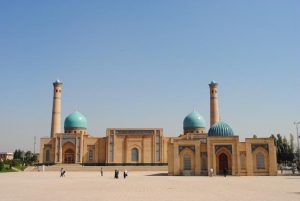Nukus is often the starting point or final destination on the tour through Uzbekistan.Notwithstanding the worsening ecological condition and the location of the modern city in the heart of the Kizil Kum desert.It is the capital of Karakalpakstan,autonomous republic inside Uzbekistan and thus the regional centre and transport hub of the republic.
The Karakalpak (Black Hat),whose ethnic umbrella gives the republic its raison d`etre,are a Turkic people whose language,traditions and clan structure have closer links to the Kazakh than the Uzbek and whose physiognomy owes more to the nomadic Mongol than to the settled Persian.Their ancestrial heartland was traditionally centred upon the lower Volga and Syr Darya rivers and northern Aral,but towards the end of the 18th century the clans were gradually driven southwest into the Amu Darya delta by relentless Kazakh aggression.Their signed treaty of friendship with the ambassador of Peter the Great in 1722 meant little in these new lands and they were made recultant and unruly subjects of the Khans of Kungrad and later Khiva.In 1827 a Karakalpak rebellion held the town of Kungrad for a time but it was bloodily suppressed by Khivan forces.In 1873 Karakalpak lands were ceded to Russia and rose restlessly under Soviet rule through the ranks of nationality from an autonomous province in the Kazakh republic(1925),to autonomy in the Russian Federation (1930),to an autonomous republic in its own right (1932),to an autonomous republic inside the Uzbek republic (1936).In these dizzy days of ethnic assertiveness the republic`s status in somewhat ambiguous,but practical autonomy stretches little furthes than a national flag,emblem and TV station.approximately 30 per cent of the population are ethnic Karakalpak,30 per cent Uzbek and 30 per cent Turkmen.Only 2 per cent are Russians,descended mainly from Cossack fishermen,and most of these are leaving.
Today the land is characterized by impending ecological disaster and entrenched popular Islam,a heady mix of environmentalists and pilgrims and a tiny trickle of tourists.

